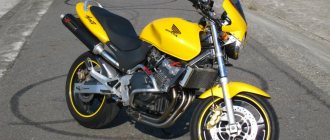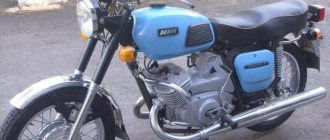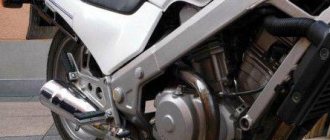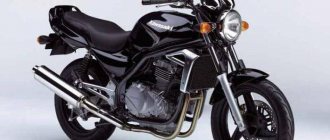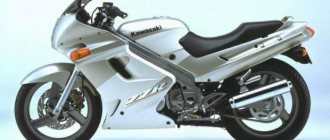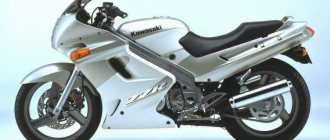Among the entire range of Yamaha motorcycles, the TRX 850, released in 1995 and introduced a year later on the European markets, stands out. Externally, the Yamaha resembles the Ducati 900 Super Sport, which makes it difficult to attribute it to a specific class: the presence of a parallel twin with not the most outstanding power and a modest hood reveal the features of a naked bike, while the short wheelbase and rigid chassis belong to sports bikes.
000_moto_0412_050
Yamaha TRX 850: 83 hp, 1995–1999, 100–180 thousand rubles.
Yamaha TRX 850: 83 hp, 1995–1999, 100–180 thousand rubles.
STORY. The Yamaha TRX 850, presented to the Japanese public in 1995 and a year later appeared in Europe, was strikingly different from the bulk of Japanese motorcycles of that time. The device, which looks quite strongly reminiscent of the Ducati 900 SuperSport, is difficult to attribute to any one class: a rigid chassis in combination with a short wheelbase clearly indicates the presence of a sportbike component, but the not very powerful parallel twin and modest hood allow us to call it rather “naked” -by bike.
The TRX 850 is equipped with an in-line two-cylinder ten-valve dry sump engine, which is, in fact, a modification of the TDM850 engine. Its not quite in-line (more likely even V-twin) character is due to the alternation of flashes every 270 degrees, just like on the TDM 850. The main differences between the “Teeriks” power unit and the “Tedeem” one are different camshafts, carburetors and modified gearbox ratios.
The engine is housed in a tubular steel space frame, similar in design to the Ducati birdcage. In addition to its interesting appearance, the frame has excellent rigidity. The “sportiness” of the chassis is complemented by suspensions and brakes borrowed from the FZR family. Both the fork and the rear monoshock are fully adjustable. The braking system components are made by Brembo, with two four-piston calipers in front combined with 320 mm discs, and a two-piston caliper at the rear.
The driver's seat is very spacious, the seat is flat, and on long trips you can change the seating position by moving back and forth. The only questionable point from a long-range point of view is the high rigidity of the seat cushions. Which, of course, can be treated if desired.
From the introduction of the Yamaha TRX 850 until its discontinuation in 1999, the motorcycle did not undergo any changes.
How much does a sports bike cost?
The price of the TRX 850, depending on the condition and year of manufacture, varies from 100 to 180 thousand rubles. At the start of mass production, the motorcycle was considered one of the most expensive in its class, which, however, was fully justified by its quality and technical characteristics.
Most of the models offered on secondary markets are sold by private individuals and former owners, which makes bargaining possible when purchasing. As a result, the cost of a particular device is greatly influenced by its condition, and not by the year of manufacture or mileage.
There are no problems with consumables and spare parts for the Yamaha TRX 850: the model was produced not only for the domestic market of Japan, but also for the markets of European countries, and most of the components are identical to the TDM 850. You should not expect any particular difficulties in operating and maintaining the TRX 850, which is undoubted advantage of the motorcycle.
001_moto_0412_050
1995. Yamaha introduced the TRX 850 in-line street bike to the public.
1995. Yamaha introduced the TRX 850 in-line street bike to the public.
FOR WHAT? For life. First of all, of course, for urban life, although the Yamaha TRX 850 is a fairly universal device. In the city, it feels like a fish in water thanks to the successful combination of a high-torque engine (the motorcycle rides confidently from 3000 rpm), excellent handling and effective brakes. The motorcycle is also suitable for long-distance driving - the presence of a semi-fairing makes the ride quite comfortable, and the engine thrust available in a wide range of revolutions allows you to confidently overtake without cranking the engine until it rings. But first of all, this is still a pre-built version for a streetfighter: you just need to “angry” the engine a little - and the TRX will turn into a real “street fighter”.
WHERE TO LOOK? Searching for a TRX 850 in “recently from the showroom” condition is a futile task; the years take their toll. Therefore, you will have to choose from what is available. The motorcycle has never ranked high in sales reports, so it is not a frequent visitor to the second-hand market. It is vanishingly rare in showrooms, although it is still possible to bring it to order - both from Japan and from Europe. A significant part of the devices sold on the Internet belong to private owners.
TUNING. The direction of “improving” the Yamaha TRX 850 is determined by the goals and objectives that are set for it. Most often, Teeriks acts as daily city transport, and in this case the minimum set is quite standard. Installing sliders (3-5 thousand rubles) or arches (which are difficult to find on sale; it’s easier to order production in Russia; they will cost 5-7 thousand rubles) will help protect the motorcycle in case of a fall. Moreover, the arcs on this device are not only more effective, but also look very harmonious. A set of two direct-flow mufflers, which are so popular among us, costs from 12 thousand rubles. for “no name” up to 20–40 thousand rubles. for the “ends” from a renowned manufacturer.
In Europe, the TRX 850 is a very popular blank for building a streetfighter; in addition, there are often cases of sharpening the “teerix” for an amateur “ring”. If you act in this direction, then in addition to the above, you can take care of changing the gear ratio by replacing the stars (2–3 thousand rubles) and selecting brake pads more suitable for such conditions (3–3.5 thousand rubles for “synthetic ones”) . By the way, riding on the rear wheel is not dangerous for the Teerix - the engine oil tank is located behind the cylinders, so the engine does not suffer from oil starvation when driving in a wheelie.
Replacing the original CV carburetors with slide carburetors (Keihin FCR series or Mikuni RS series) will also help to significantly “piss off” the TRX. The budget for this event is 15–20 thousand rubles. when buying new or 8–12 thousand rubles. for used carburetors. At the same time, it is worth installing low-resistance filters (2-4 thousand rubles).
If the fork stiffness is not enough even when all adjustments are tightened to the maximum, replacing the cartridges will help. A more budget-friendly solution is to pour harder oil into the fork. Mega-tuning is also often found in the form of installing a third crossbar connecting the moving parts of the feathers. I don’t know how noticeable the increase in fork stiffness is, but thanks to the placebo effect, a positive is at least guaranteed.
The TRX 850's seats aren't the best for long-distance driving. A more comfortable alternative produced by Corbin will cost 8–10 thousand rubles. for a driver's license and 7 thousand rubles. - for passenger. You can limit yourself to an inflatable pillow for the driver or passenger seat from AirHawk (5.5 thousand rubles).
A “tourist” windshield from MRA or Zero Gravity costs 4.5–6 thousand rubles. The installation of heated steering wheel grips will also add convenience to the motorcycle. The price of Oxford ones is 3.5–4.5 thousand rubles, Saito is cheaper – 2.5–3.5 thousand rubles. It wouldn’t hurt to resolve the issue of luggage transportation. A top case with a volume of 40 to 52 liters costs 8–12 thousand rubles, another 2–4 thousand rubles. you will need a platform for attaching it.
PRICES. Despite the rather high price of the new Yamaha TRX 850 in the years of their release, the budget for purchasing a used device is comparable to the price tags for the popular “400”. Prices for the Yamaha TRX 850 are in the range of 100–180 thousand rubles, deviations in one direction or another depend on the degree of wear and tear of the motorcycle, the urgency of the sale, or, conversely, the greed of the seller.
The bulk of the “Teeriks” appearing in advertisements for sale belong to private individuals, so no one has canceled the auction. In any case, the price of a particular device is determined to a greater extent by its condition than by mileage or year of manufacture.
The cost of servicing the Teerix is low, and there are no problems with spare parts and consumables: firstly, the motorcycle was produced for both the Japanese and European markets, and secondly, a significant part of the parts are identical to spare parts for the much more popular TDM 850. Liquidity of the TRX 850 cannot be called high, but one should not expect any difficulties with the further sale of “Japanese Ducati”.
CHOICE. When choosing a Yamaha TRX 850, you should remember that this engine is one of those, thanks to which the nickname “oil-guzzler” stuck to Yamaha motorcycles for a long time. This, of course, does not mean that an outstanding oil appetite is inherent in all engines, but you can’t fool physics: after all, the TRX 850 has five valves per cylinder. Oil burns appear first of all if you constantly rev the engine to the red zone or drive for a long time on the highway at high speed. This can be treated by replacing the valve stem seals and rings (see “Moto” No. 2–2012). By the way, rings are sold only as a set; the cost of spare parts and replacement work is usually 10–12 thousand rubles.
Like other motorcycles, the TRX 850 requires regular inspection, once every 12–15 thousand km, and, if necessary, adjustment of valve clearances. As with other motorcycles in Russia, most owners neglect this matter. In particularly advanced cases, you may need to replace both valves and seats.
Of course, not every seller admits that the engine of his device burns oil. So it's better to check it. After the engine has warmed up, try holding a sheet of white paper near the muffler opening. If a thick black spot appears on the sheet or, even worse, black drops are visible, it is better to refuse the purchase.
Some TRX 850 owners forget to drain the contents of the oil tank when changing the oil, being surprised that when the oil filter is unscrewed, only about a liter of lubricant flows out. And the main drain bolt-plug is located on the left side of the engine, at its lowest point. Therefore, unobtrusively ask the seller how the oil on this motorcycle is changed, and if it turns out that only by unscrewing the oil filter cap, do not purchase it.
Problems with carburetors also occur on TRX. Known from a number of other motorcycles, Mikuni BDST starts to prepare a mixture that is too rich and cannot be adjusted. This happens because the needle breaks the well of the atomizer and wears out itself. It is treated by replacing needles and wells or installing used carburetors. In both cases, the budget will be 8–12 thousand rubles.
There are also difficulties with the gearbox. If during a test drive on the Teerix it turns out that the second gear is not engaged or falls out, you should prepare to repair the gearbox. The budget depends on the degree of destruction of the unit. In particularly advanced cases, restoring the functionality of the box can cost 30–40 thousand rubles.
The suspension of the TRX 850 is simple and reliable; it has no pronounced “pain points”. The same goes for the brakes. The main thing is to make sure that time has been kind to the calipers and that they have not soured. Otherwise, you may end up having to repair them and replace worn-out brake discs.
The Teeriks steel frame is not only reliable, but also repairable - in case of minor problems, a more or less competent welder can handle them.
You don’t have to pay much attention to the degree of tire wear - the “donuts” on the TRX 850 are of a modest size, the rear ones are 160/60–17, and the prices for tires of this size are very humane.
Why should you buy the TRX 850?
Despite the fact that the motorcycle is considered a universal model, most motorcyclists buy it for trips in the city. The motorcycle's efficient front brakes, perfect handling and excellent maneuverability make the TRX 850 the optimal bike for commuting on city streets. However, it can also be used on country roads: the semi-fairing makes the ride comfortable, maintaining traction throughout the entire speed range allows you to quickly pick up speed without revving the engine. However, the TRX 850 is an ideal option for street racing: it is enough to slightly increase the engine power to turn the motorcycle into a full-fledged sportbike.
009_moto_0412_050
The design and appearance in the Ducati style, combined with the ease of maintenance of the “Japanese” - this is the Yamaha TRX 850.
The design and appearance in the Ducati style, combined with the ease of maintenance of the “Japanese” - this is the Yamaha TRX 850.
| ESTIMATED COST OF CONSUMABLES AND SPARE PARTS | ||
| Name | Original spare parts, rub. | Non-original spare parts, rub. |
| Oil filter | 800 | 250–400 |
| Air filter | 2500 | 1500 |
| Front brake pads | 5200 | 2300–3000 |
| Rear brake pads | 2800 | 1500–1800 |
| Chain and sprockets, set | 18000 | 5500–8000 |
| Brake/clutch levers | 1500 | 500–1000 |
| Frame sliders | — | 3000–5000 |
COMPETITORS.
Where can I buy?
It is impossible to find a brand new Yamaha TRX 850 today - after all, a lot of time has passed since the end of mass production, so fans will have to choose a model on the secondary market. The best option is to bring the TRX 850 from Japan to order. Most of the motorcycles offered on the market belong to private owners.
Crankshaft 270° [edit]
Main article: Straight twin § 270°
Main article: Crossplane § 270° straight-twin cranks
Although the 270° crank concept was credited to Australian Phil Irving (of Vincent fame), [8] the TRX was the first [13] production motorcycle to use this innovation. The 270° crank has a firing sequence and engine balance that produces something of a shaped twin. Unlike the 180° and 360° parallel twins, in a 270° moving engine both pistons never remain stationary, so its flywheel torque is continuous. [3] With less vibration than a 360° crank and a more uniform pattern than a 180° crank, the 270° crank produces a smoother engine. Any residual unevenness in the 270° firing interval is said to provide more efficient power transfer to the rear tire. [14]
Stuart Wood, Triumph's chief engineer, stated that the 270° crank is ideal for high-power parallel twins as it "generates less annoying high-frequency secondary vibration." [15] After the demise of the TRX, the 270° concept became a successful compromise for standard and cruiser motorcycles. [16] The parallel-twin layout is experiencing something of a renaissance (the latest version of the Honda Africa Twin is a 270° twin rather than the earlier incarnation of a V-twin). Manufacturers are even adopting the parallel-twin format for high-performance sportbikes such as the (discontinued) MZ 1000S and Métisse Mk5. [9] [17] [18]
Brakes and suspension
The Yamaha TRX 80 suspension is reliable, simple in design and almost completely free of problems. The situation is similar with the brake system, which only requires checking the condition of the brake discs and calipers. If not properly maintained, brakes and discs may need to be replaced. During hard braking, the brakes provide effective traction and quick stopping of the Yamaha TRX 850. The technical characteristics of the rear brake are somewhat let down: it can easily lock the rear wheel.
Comfort level
A light and rigid frame, coupled with equally rigid suspensions, provides the Yamaha TRX 850 with ideal handling and equates it to full-fledged sportbikes, allowing it to easily maneuver at high speeds and take sharp turns.
Hard suspensions and frames, unfortunately, have a negative impact on the level of comfort: the driver and passenger seats are not soft, and the sports suspension makes the motorcycle too aggressive and not intended for a quiet ride. The questionable performance of the transmission also worsens the situation and the overall impression of the TRX 850.
Body kit and frame
The motorcycle is equipped with a steel frame that is reliable and maintainable—any defects associated with it can be repaired by a non-professional welder. The design of the frame is very reminiscent of the Ducati birdcage. The installed half-fairing protects against oncoming air flow.
The Yamaha TRX 850 is equipped with rather modest wheels: 160/60-17 tires are installed at the rear. Replacing tires is very inexpensive and allows you to save a lot of money, since new tires have an affordable price.

